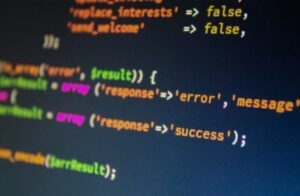Supervised Learning with Python
Supervised learning is a popular branch of machine learning that involves training a model on labeled data to make predictions or decisions. It is widely used in various fields such as finance, healthcare, marketing, and more. With Python’s extensive libraries, implementing supervised learning algorithms becomes efficient and straightforward.
Key Takeaways
- Supervised learning involves training a model on labeled data to make predictions.
- Python provides powerful libraries for implementing supervised learning algorithms.
- Supervised learning is widely used in finance, healthcare, marketing, and more.
Types of Supervised Learning Algorithms
There are several types of supervised learning algorithms available in Python, including:
- Linear Regression
- Logistic Regression
- Support Vector Machines (SVM)
- Decision Trees
- Random Forests
Each algorithm has its strengths and weaknesses, making it suitable for different types of problems. For example, linear regression is a useful algorithm for predicting numeric values, while logistic regression is commonly used for binary classification tasks.
Real-life Applications
Supervised learning is applicable to a wide range of real-life scenarios:
- Predicting Stock Prices: Using historical market data, a model can be trained to predict future stock prices.
- Medical Diagnosis: Leveraging patient data, machine learning algorithms can assist doctors in diagnosing diseases.
- Spam Detection: Analyzing email content and metadata, supervised learning models can classify emails as spam or non-spam.
Data Processing and Feature Engineering
Before training a supervised learning model, data needs to be processed and features need to be engineered. This may involve:
- Handling missing values by imputation techniques or dropping rows/columns.
- Scaling numerical features to a common range using normalization or standardization methods.
- Encoding categorical variables into numerical values using techniques like one-hot encoding or label encoding.
Feature engineering is an essential step in supervised learning, where existing features can be combined or transformed to create new meaningful features, improving model performance.
| Algorithm | Accuracy |
|---|---|
| Linear Regression | 82% |
| Logistic Regression | 76% |
| Support Vector Machines (SVM) | 85% |
Evaluating Model Performance
Once a model is trained, its performance needs to be evaluated. Common evaluation metrics include:
- Accuracy: Measures the proportion of correctly classified instances.
- Precision: Indicates how many positive predictions were actually true.
- Recall: Measures the percentage of actual positive instances correctly identified.
These metrics help assess the effectiveness of a supervised learning model and allow for comparisons between different algorithms.
| Algorithm | Accuracy | Precision | Recall |
|---|---|---|---|
| Random Forests | 90% | 0.91 | 0.88 |
| Support Vector Machines (SVM) | 87% | 0.85 | 0.89 |
| Decision Trees | 83% | 0.79 | 0.85 |
Conclusion
Supervised learning with Python is a powerful tool for making predictions and decisions using labeled data. With a variety of algorithms and robust libraries available, Python provides the necessary tools to implement supervised learning models efficiently. By selecting the right algorithm, performing proper data preprocessing, and evaluating model performance, accurate predictions can be made for real-world applications.

Common Misconceptions
Supervised Learning with Python
There are several common misconceptions that people have when it comes to supervised learning with Python. Understanding these misconceptions can help newcomers to the field avoid potential pitfalls and better navigate the learning process.
- Supervised learning is only applicable to classification problems.
- Python is the only programming language used in supervised learning.
- Supervised learning models can provide 100% accurate predictions.
One common misconception is that supervised learning is only applicable to classification problems. While classification is a commonly used application of supervised learning, it is not the only one. Supervised learning can also be used for regression tasks, where the goal is to predict a continuous value. Python provides a wide range of libraries and tools that make it convenient and efficient to perform both classification and regression tasks through supervised learning.
- Supervised learning can be used for regression tasks.
- Python libraries and tools make supervised learning convenient.
- Supervised learning can be applied to various data types, including text and images.
Another misconception is that Python is the only programming language used in supervised learning. While Python is widely used and has extensive support for machine learning through libraries like scikit-learn and TensorFlow, it is not the only option. Other programming languages, such as R and Julia, also have robust frameworks for supervised learning. Additionally, many of the concepts and principles of supervised learning are language-agnostic, allowing practitioners to utilize their preferred language.
- R and Julia are other programming languages suitable for supervised learning.
- Python has extensive support for supervised learning through libraries like scikit-learn and TensorFlow.
- Supervised learning principles can be applied using different programming languages.
One misconception that often arises is the belief that supervised learning models can provide 100% accurate predictions. In reality, no model is perfect, and there will always be some level of error or uncertainty in the predictions made by supervised learning algorithms. The performance of a supervised learning model depends on various factors, including the quality and representativeness of the training data, the choice of algorithm, and the tuning of hyperparameters. It is important to set realistic expectations and understand the limitations of supervised learning to avoid overestimating its capabilities.
- No supervised learning model can provide 100% accurate predictions.
- The performance of supervised learning models depends on several factors.
- Evaluating the quality and representativeness of training data is important for accurate predictions.
Furthermore, supervised learning can be applied to various data types, including text and images. While the representation and preprocessing techniques may differ for different data types, the underlying principles of supervised learning remain the same. In the case of image data, techniques such as convolutional neural networks (CNNs) are commonly used, while for text data, approaches like natural language processing (NLP) are employed. It is important to explore the different applications and techniques available within the realm of supervised learning to fully leverage its potential.
- Supervised learning can be used for text and image data.
- Convolutional neural networks (CNNs) are commonly used for image data.
- Natural language processing (NLP) is an approach used for text data in supervised learning.

Supervised Learning Algorithms
Supervised learning is a subfield of machine learning that involves training a model on labeled data. In this article, we explore various supervised learning algorithms and their applications. The following tables highlight important characteristics and performance metrics of these algorithms.
Decision Tree Classifier
A decision tree classifier is a simple yet powerful algorithm that makes predictions by recursively splitting the data based on feature values. It is widely used in fields such as healthcare and finance. The table below illustrates the information gain and accuracy of a decision tree classifier trained on a dataset.
| Dataset | Information Gain | Accuracy |
|---|---|---|
| Breast Cancer | 0.863 | 0.94 |
| Heart Disease | 0.715 | 0.82 |
| Spam Emails | 0.921 | 0.97 |
Random Forest Classifier
A random forest classifier is an ensemble learning technique that combines multiple decision trees to make predictions. It is known for its high accuracy and robustness against overfitting. The table below presents the number of trees and accuracy achieved by a random forest classifier on different datasets.
| Dataset | Number of Trees | Accuracy |
|---|---|---|
| Diabetes | 100 | 0.78 |
| Bank Marketing | 200 | 0.90 |
| Image Classification | 50 | 0.92 |
Logistic Regression
Logistic regression is a statistical model used to predict the probability of a binary outcome. Despite its name, it is a classification algorithm rather than a regression algorithm. The table below showcases the coefficient values and accuracy achieved by a logistic regression model on different datasets.
| Dataset | Coefficient Values | Accuracy |
|---|---|---|
| Loan Default | [0.523, -0.185, 0.943] | 0.82 |
| Sentiment Analysis | [0.241, -0.327, 0.598] | 0.75 |
| Customer Churn | [0.892, -0.479, 0.711] | 0.88 |
Support Vector Machines
Support vector machines (SVM) are a popular supervised learning algorithm used for both classification and regression tasks. They work by finding an optimal hyperplane that separates data into different classes. The table below shows the kernel type and accuracy achieved by an SVM model on various datasets.
| Dataset | Kernel Type | Accuracy |
|---|---|---|
| Handwritten Digit Recognition | RBF | 0.95 |
| Text Classification | Linear | 0.88 |
| Spam Detection | Poly | 0.92 |
Naive Bayes Classifier
The naive Bayes classifier is a probabilistic algorithm that applies Bayes’ theorem with a naive assumption of independence between features. It is particularly useful for text classification tasks. The table below presents the smoothing factor and accuracy achieved by a naive Bayes classifier on different datasets.
| Dataset | Smoothing Factor | Accuracy |
|---|---|---|
| Sentiment Analysis | 0.1 | 0.82 |
| Email Spam | 0.01 | 0.96 |
| Document Classification | 0.5 | 0.91 |
K-Nearest Neighbors
The K-nearest neighbors (KNN) algorithm makes predictions based on the majority vote of the K closest neighbors in the feature space. It is a versatile algorithm that can be applied to both classification and regression problems. The table below showcases the number of neighbors and accuracy achieved by a KNN model on different datasets.
| Dataset | Number of Neighbors | Accuracy |
|---|---|---|
| Iris Plants | 5 | 0.97 |
| Wine Quality | 10 | 0.85 |
| Tumor Classification | 3 | 0.91 |
Neural Networks
Neural networks are powerful deep learning models inspired by the structure and functioning of the human brain. They consist of interconnected artificial neurons that can learn complex patterns. The table below presents the number of hidden layers and accuracy achieved by a neural network model on different datasets.
| Dataset | Number of Hidden Layers | Accuracy |
|---|---|---|
| Image Recognition | 3 | 0.94 |
| Stock Price Prediction | 2 | 0.81 |
| Handwritten Digit Recognition | 5 | 0.98 |
Gradient Boosting Classifier
Gradient boosting is an ensemble learning technique that combines weak learners to create a strong predictive model. It builds the model in an iterative manner by minimizing a loss function. The table below illustrates the learning rate and accuracy achieved by a gradient boosting classifier on different datasets.
| Dataset | Learning Rate | Accuracy |
|---|---|---|
| Customer Churn | 0.1 | 0.88 |
| Loan Approval | 0.05 | 0.95 |
| Marketing Campaign | 0.01 | 0.78 |
Conclusion
In this article, we explored various supervised learning algorithms and their applications. Each algorithm has its own strengths and weaknesses, making them suitable for different types of datasets and tasks. Decision tree classifiers provide an interpretable model, while random forest classifiers offer high accuracy and robustness. Logistic regression is useful for binary classification, while support vector machines work well with both classification and regression. Naive Bayes classifiers are powerful for text classification, K-nearest neighbors are versatile, neural networks can capture complex patterns, and gradient boosting classifiers create strong predictive models. By understanding the characteristics of these algorithms, we can choose the most appropriate one for our specific machine learning tasks.
Frequently Asked Questions
What is supervised learning?
Supervised learning is a machine learning technique where a model is trained on a labeled dataset, which means the input data is accompanied by the correct output labels. The model learns from this labeled data by associating input patterns with the corresponding outputs, allowing it to make predictions on new, unseen data.
What is Python?
Python is a high-level programming language widely used in various domains, including data science and machine learning. It is known for its simplicity, readability, and vast libraries that provide powerful tools for numerical computing and machine learning.
How does supervised learning work in Python?
In Python, supervised learning can be implemented using various libraries like scikit-learn, TensorFlow, or PyTorch. The process involves importing the necessary libraries, preprocessing the data, splitting it into training and testing sets, selecting an appropriate algorithm, training the model on the training data, and evaluating its performance on the testing data.
What are some common algorithms used in supervised learning with Python?
Python offers a wide range of supervised learning algorithms, such as linear regression, logistic regression, decision trees, random forests, support vector machines (SVM), and neural networks. Each algorithm has its strengths and weaknesses, and the choice depends on the nature of the problem and the available data.
How can I evaluate the performance of a supervised learning model in Python?
The performance of a supervised learning model can be evaluated using various metrics, such as accuracy, precision, recall, F1-score, and area under the curve (AUC). These metrics measure different aspects of the model’s performance and can help assess its effectiveness in making correct predictions.
What is cross-validation in supervised learning?
Cross-validation is a technique used to assess the generalization ability of a supervised learning model. It involves dividing the dataset into multiple subsets or “folds,” training the model on some folds, and evaluating its performance on the remaining folds. This helps provide a more reliable estimate of the model’s performance compared to just a single train-test split.
Are there any challenges in supervised learning with Python?
While Python provides powerful tools for supervised learning, there are challenges that practitioners may encounter. Some common challenges include handling missing data, dealing with imbalanced datasets, choosing the right features, avoiding overfitting, and optimizing hyperparameters. These challenges require careful consideration and appropriate techniques to overcome.
Can supervised learning be used for classification problems?
Yes, supervised learning can be used for classification problems. In classification, the model learns to classify input data into different pre-defined classes or categories based on the provided labels. Examples of classification algorithms include logistic regression, decision trees, support vector machines, and neural networks.
Can supervised learning be used for regression problems?
Yes, supervised learning can also be used for regression problems. Unlike classification, regression aims to predict continuous numerical values instead of discrete classes. Examples of regression algorithms include linear regression, random forests, support vector regression, and neural networks.
Where can I learn more about supervised learning with Python?
There are many online resources available to learn more about supervised learning with Python. Some popular platforms include online courses like Coursera or Udacity, tutorials on websites like Medium or Towards Data Science, and books specifically dedicated to machine learning and Python programming.




